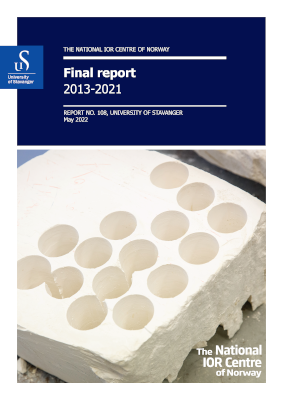Final report 2013-2021
Keywords:
oil recovery, Norwegian Continental ShelfSynopsis
The National IOR Centre of Norway strived for developing methods and tools to support cost efficient and environmentally friendly solutions for improved oil recovery on the Norwegian Continental Shelf. Academic excellence and close cooperation with the industry have been key factors for the success of the Centre.
The Centre (2013-2021), hosted by the University of Stavanger, included two research partners, the national research organizations IFE and NORCE. The Centre’s consortium comprised seven companies from the oil and gas sector and two service companies. The latter contributed to the Centre with both with in-kind funding and research.
The research team has published almost 200 journal papers in the duration of the Centre and has given more than 700 presentations as conference contribution or scholarly presentations. Several researchers in the team have received awards related to their contributions in the oil and gas industry during the Centre lifetime; examples are the NPD IOR Award (Svein M. Skjæveland, 2018; Geir Evensen, 2020) and the SR Bank’s Innovation Award (Arild Lohne and Oddbjørn Nødland, 2017).
A large part of the activities involved the education of 30 PhDs (15 completed by 2021) and 15 postdocs. They have been contributing to delivering and disseminating research results in the research community and broader audience. International cooperation has been a key component of the Centre with mobility of students and rese- archers in Europe, North America and Asia.
The Centre conducted research on oil recovery at multiple length scales and conveyed competencies from several scientific fields (among others, geology, reservoir chemistry, material science, computational engineering and methods, advanced mathematics and physics). The activities included both experimental and modelling work which complemented each other. Being able to connect (oil) recovery mechanisms at length scales spanning from core to pore and field scale require both in depth understanding of mechanisms and effect of parameters at each scale and a more holistic view of the problem at hand.
The industry views exchanged during regular technical and board meetings, targeted workshops, annual conference and delivery forums contributed to keeping high level of relevance of the Centre activities towards applications and operational settings.
The knowledge generated in the Centre has been organised in an online archive at the University website easily accessible to part- ners and interested parties. Furthermore, the Centre gave rise to several initiatives within education, research and innovation. The Petrosenter NCS2030 was granted funding by NFR in December 2021 and, with a similar collaboration between aca- demia and industry as in the IOR Centre, will expand the research focus on the topics within sustainable subsurface utilization. The Subsurface Academy is an initiative by the University of Stavanger within the education aspect and focus on preserving subsurface competence and extending it to cope with future energy challenges. A newly granted project funded by the HKDir started in January 2022 with 5 industry partner and will investigate how the university can best support the challenges of the future in the energy sector. The development of software and simulation tools in the Centre has also seen the spin off of an innovation project with industry partners that will investigate commercialization options.


